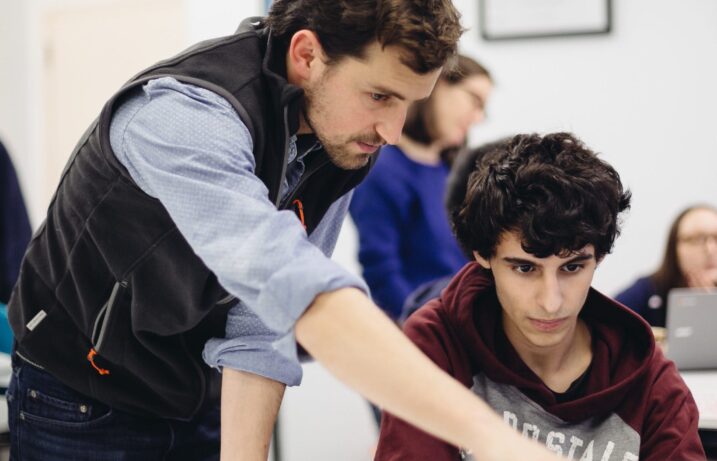Imagine yourself five years from now. You’ve been asked to give a talk sharing how you quit your traditional job, went to coding school, and became a successful developer at a major tech company.
After your speech, a ton of people rush up to you. They ask for your business card, your email address—some even say, “Are you available as a mentor?” You understand their eagerness; after all, you were them five years ago, and the tech world is pretty intimidating when you’re just starting out.
However, asking a virtual stranger to be your Sheryl Sandberg isn’t the most effective way to get a mentor.
That’s why we’ve put together this guide to getting a mentor in tech. By the end, you’ll know how to spot a great potential mentor, where to find one, how to get the ball rolling, and the concrete actions you can take to make the relationship last. Ready to get started? Let’s go.
Anatomy of a Good Mentor
Before you go looking for a mentor, you need to know what a good one looks like. Many people think of their dream mentor as someone who’s really well-connected, well-known, or experienced. However, these people often will be too busy to talk to you on a regular basis—and that’s assuming they form a mentorship relationship with you in the first place.
The true trifecta of a good mentor = available, knowledgeable, and trustworthy.
Available simply means this person would be willing to periodically set aside time to help you. This commitment doesn’t have to be formal (i.e., “We’ll meet every Friday at 1 P.M.”), although it certainly can be.
Knowledgeable means this person would have enough insight into what you’re dealing with to give you solid advice. For example, if you work at a massive fintech company, you may want a mentor who’s worked at a huge business as well, a mentor who’s in the fintech industry, or both.
Trustworthy means this person would be honest with you, even when the truth is hard to hear. A mentor can be supportive, but he or she isn’t just a cheerleader—he or she is also a teacher and a coach.
Now that you know which qualities to look for, you’re probably wondering where to look.
Step 1: Find a Potential Mentor
Source #1: The Office
It’s much easier to find a mentor at work than anywhere else. Not only do you spend the majority of your time there, but it’s already set up in a quasi-mentor format, with more trained people passing down information to less trained people.
First, ask yourself if anyone is already mentoring you informally. Do you always go to a certain team member for coding help? Does your manager frequently ask you about your career goals and current challenges? Has one of the senior developers seemed particularly receptive to your requests for advice?
If you have one (or more) of these coworkers, awesome! Your next step is to deepen the relationship (more on that in a bit). But if you don’t, that’s totally okay. Try to find someone who seems like a good mentor candidate (using the qualities outlined above).
Source #2: Tech Events
You might not have much luck asking event speakers to be your mentors; however, the other attendees at tech events (conferences, meetups, hackathons, classes, workshops, roundtables, etc.) are fair game.
At these events, try to meet people who seem like they’re one to ten years further along in their careers than you. You should already be collecting contact info from those with whom you hit it off, but take special note of the connections you make with mentorship potential.
Source #3: Informational Interviews
Sometimes, you’re looking for a very specific person to be your mentor. For instance, if you’re a DevOps engineer at, say, The Wall Street Journal, you might be looking for someone who’s also in the media industry. Or maybe you’re interested in creating iOS apps for the blind and visually impaired; you’d likely want a mentor who’s produced several apps and/or knows about accessibility best practices.
Having such distinct criteria is actually a good thing, as it helps you narrow down the field of potential mentors. Use Google and LinkedIn to find people who fit the bill. Wondering what that would look like? Using the first example, you could search for “DevOps engineer media New York City,” or “developer news industry NYC.” Of course, mentors don’t need to live in the same city as you—there are plenty of virtual mentorships—but it’ll be easier to ask for an informational interview if they do.
Once you’ve got four to seven options, shoot them each an email requesting a coffee meeting. Here’s an template for inspiration:
Subject line: “Would Love to Learn More About Your Career (Over Coffee?)” or “Impressed by Your Success—Can I Buy You Coffee?”
Message:
Dear ,
Congratulations on ! As a who’s interested in , I find your success extremely inspiring. Would you be open to meeting me for coffee and sharing more about ? I’m sure you’re busy, so I’d be grateful for even 20 minutes of your time.
Best,
If you send out coffee requests to four to seven people, you’ll probably get “yes’s” from two to five, giving you plenty of possible mentors.
Step 2: Deepening the Relationship
At this point, you should have identified and made contact with at least one person with mentorship potential.
Whether they’re a coworker, networking connection, or stranger, your next step is the same: ask them to grab lunch with you.
Don’t be secretive about the reason—you want to immediately establish the professional, coaching nature of the relationship. Here’s how you’d frame that request to a coworker or connection:
Hi ,
What’s your schedule looking like ? Since you’re really experienced in , I was hoping to take you to lunch and get your advice on a couple related things, specifically . Happy to work with your schedule (slash choose your favorite restaurant!)
Best,
This message establishes why you’re reaching out and what you’re hoping to learn—plus, it flatters the recipient. Keep in mind, you should change the tone depending on how well you know them and how senior to you they are. If you were emailing someone several rungs above you, for instance, you’d want to be more formal.
If you’re following up with someone who met you for coffee, use this template instead:
Dear ,
Thanks again for meeting me for coffee . Your advice was so helpful—I ended up using to . I know you’ve got a lot on your plate, but would you be open to ? Please feel free to say no; I’ve just already learned so much from you, and getting your wisdom and expertise would be, well, amazing.
Best,
P.S. I stumbled across this that reminded me of our conversation on . Check it out, it’s pretty cool!
While you can definitely make this template your own, be sure to explain how you’re already implementing their guidance (which will make them feel fantastic) and “pitch” the mentorship. If you don’t, they might wonder what you’re shooting for.
Also, the postscript is key. Even though by definition your mentor has more knowledge, experience, and wisdom than you, that doesn’t mean you’re off the hook for providing value. Mentorships fail when they’re too one-sided—so you should always be striving to give back to your mentor. Which brings us to the last step…
Step 3: Giving and Taking Value
By now, you should have met with your potential mentor a couple times. If the interactions have been educational and positive, move forward with the process.
This next stage will vary slightly depending on who your mentor is. If you met them at work or a networking event, ask them if they’d be willing to set aside some time on a regular basis to meet with you. (Use the above template for inspiration.) If you’re talking to an informational interviewee, then you’ve already officially asked them to mentor you.
After that, you should have two main goals:1) Adding value to your mentor’s life and career2) Getting insights, feedback, and support from themThe first goal is a little less intuitive. You can enhance your mentor’s life by teaching them new skills, giving them feedback, introducing them to people, helping them with projects, nominating them for honors and awards, publicly recognizing them, and sharing information with them.
Here are concrete examples of each:
New skills: You used to be an accountant, so you show your mentor which tax refunds he’s currently not taking advantage of.
Feedback: You help your mentor practice for her upcoming presentation and tell her where the speech could be stronger.
Introductions: Your mentor is going to the West Coast, so you connect him to a couple cool people you know out there.
Projects: You design some graphics for an app your mentor is creating on the side.
Honors and awards: You nominate the site your mentor’s company produced for a Webby.
Public recognition: You write a blog post about what you’ve learned from your mentor.
Information: You send her a cool article about Airbnb’s design process.
Finding, securing, and keeping a mentor clearly isn’t an easy or speedy endeavor. But trust us, it’s worth the time and energy—when you’re confused, unsure, anxious, or lost, being able to call someone up and say “What do I do?” can make all the difference.
Feeling ready to learn how to program and move into a tech career? You can get started for free on Learn.
This post was written by Aja Frost, who covers business, tech, productivity, and careers.




